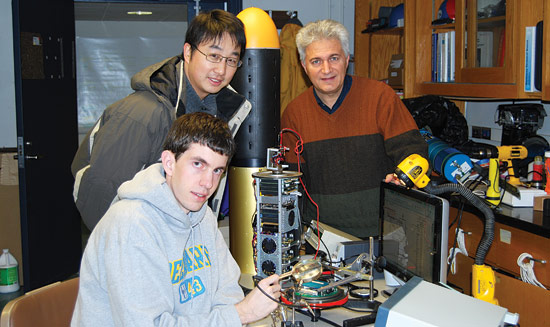
By elizabeth boyleCollege of Earth, Ocean, and Environment

Autonomous underwater vehicles swim untethered through the ocean collecting data in places scientists could never go themselves. Thanks to University of Dela-ware researchers, these tools of the marine studies trade are being upgraded and adapted in new ways.
A UD technology is improving the communications abilities of the torpedo-shaped devices. It lets scientists transmit data back and forth with the AUV as needed, much as if they were using a dial-up Internet connection. Until now, scientists were limited to waiting until an AUV returned from a mission in order to retrieve data or to send the vehicle off in a new direction.
The advancement opens the potential for real-time data streaming. "We hope this leads to technology that lets AUVs communicate even faster so that scientists and AUVs can communicate continuously," said Aijun Song, assistant professor of physical ocean science and engineering (POSE) and a collaborator on the project.
The technology's creation involved the development of hardware and instrumentation, as well as software to decode communication signals under water. It is based on cell phone technology, but with one major difference: Instead of relying on radio waves moving through the atmosphere, it uses sound waves moving through the water.
"The radio waves that are used in the atmosphere can't be used in the ocean because they don't penetrate the water," said project leader Mohsen Badiey, professor and director of UD's POSE Program.
Members of the research team are working through UD's Office of Economic Innovation and Partnerships to patent two inventions based on the project, which is funded in part by the U.S. Navy through Office of Naval Research and Defense University Research Instrumentation Program grants.
First to benefit from this new technology will be the users of UD's AUV, which is serving as the test vehicle for the project. Known as Dora (short for Delaware Oceanographic Research Autono-mous underwater vehicle), the robot has helped study everything from coral reefs off the Caribbean island of Bonaire, to a Byzantine shipwreck in the Black Sea, to underwater habitats in Delaware Bay.
And Dora continues to grow her resume. Working with partners Weston Solutions Inc. and Geometrics Inc., in November 2010 UD received a $1 million grant from the Department of Defense Environmental Security Technology Certification Program to integrate the AUV with instrumentation expected to facilitate underwater munitions and explosives detection.
"This project brings the age of robotics into unexploded munitions detection to reduce the threats to humans and to make detection more efficient," said Art Trembanis, assistant professor of geological science and Dora's chief operator.
The AUV will be outfitted with a total field magnetometer, which locates iron-containing objects such as bombs, shells and rockets. Such objects were used or discarded in coastal and ocean waters, swamps, rivers and lakes around the world during military combat, training and weapons testing.
Today those unexploded munitions, which may still detonate despite their age, pose a physical threat to everyone from contractors clearing underwater routes for telecommunications, to dredge operators, and fishermen bringing in their nets. The materials also threaten the environment as they deteriorate and leach toxic chemicals.
Integrating the magnetometer with the AUV is expected to provide cost savings over current approaches by requiring less manpower for operation and reducing or eliminating the need for support from a large ship. Other expected benefits include improved safety, portability, maneuverability and the ability to operate multiple sensing systems simultaneously.